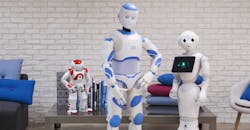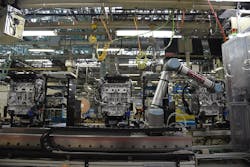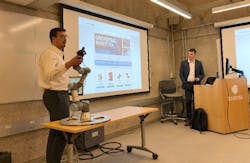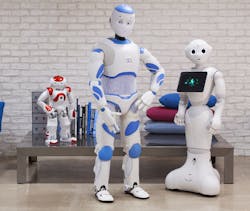A Bright Future Awaits Prospective Robotics Engineers
The future of engineering lies in our youth. If we want that future to be a successful one, these engineers of tomorrow need to learn how to navigate new technology fields. One such tech wave is the evolution of robotics. As the labor force continues to give the manufacturing industry headaches, robots will become the number one automated labor source. I recently took a trip to Yale University, along with Universal Robots, to speak to ASME students about what’s in store for robotics and the robot market.
The Future of Automation
In recent years, new industries and technologies have entered the engineering market. New waves of technology such as 3D printing and computer-aided simulation, Internet of Things, artificial intelligence and machine learning, and sensing and data analytics have created new automation fields that did not exist 10 years ago. In turn, they’re building an automation-centric manufacturing future.
Robots and collaborative robots will dominate the future of automation in aiding the labor market.
Of course, it is impossible to discuss the future of automation without talking about robots. Robots are now becoming the go-to solution to ease labor concerns. In the past, industrial robots were used for large assembly to accomplish tasks that weren’t achievable by humans, with car manufacturing being a prime example. The highest number of orders for robots ever recorded happened in the first nine months of 2017. Orders of robots in North America totaled 27,294, selling for approximately $1.473 billion overall. These figures represent growth of 14% in units and 10% in dollars compared to the first nine months of 2016.
Today we live in the world of collaborative robots or cobots. Cobots, as we have discussed here on Machine Design, are robots that have built-in safety features that can perform tasks right next to human operators. In 2017, collaborative robots (cobots) began to overtake the robotic market. According to BIS Research, by 2021, the collaborative-robot market is expected to grow to approximately $2 billion and 150,000 units.
Universal Robots’ engineers Christopher Savoia and Zachary Tomkinson demonstrate how to program the UR3 cobot and its safety features to ASME students.
To help drive home the idea of cobots, Universal Robots brought its UR3 to demonstrate the ease of programming and safety of cobot design. The UR3 can be programmed via the GUI-based programming found on the connected computer or with the tablet. You can also train the robot by placing it in the desired position, recording the placement, and repeat. Once you have recorded all your positions, the software interpolates the travel.
Safety is inherent in the robot. The robot is force-limited and registers if an abnormal force is experienced during its trajectory. The current in the actuator is used to monitor the force that is registered on the robot arm. Different force thresholds can be set to reduce or increase the safety level, which allows the user to set lower speeds and force thresholds for function in human or non-human settings. The UR cobot achieves a PL=d Category 3 ISO risk assessment. These safety requirements are the minimum requirement necessary to achieve the ISO 10218 standard for robotic cells.
Advice to Future Engineers
I wanted to stress to the students at ASME that the future is bright in the field of robotics. In 2015, a poll of 200 senior corporate executives conducted by the National Robotics Education Foundation identified robotics as a major source of jobs for the United States. Indeed, some 81% of respondents agreed that robotics was the top area of job growth for the nation.
Many predict that robots will significantly hurt the labor force. Over the seven-year period from 2010 to 2016, 136,748 robots were shipped to US customers—the most in any seven-year period ever recorded by the U.S. robotics industry. In that same period, manufacturing employment increased by 894,000, and the U.S. unemployment rate decreased from 9.8% in 2010 to 4.7% in 2016.
Robots are not limited to the industrial space. They will also be found in the medical industry, used for search and rescue, and for entertainment purposes.
Currently, we are entering a robot war with China. China’s government has initiated the technology program “Made in China 2025,” and one of its goals is to increase the country’s robot production and usage. This is a five-year plan to rapidly expand its industrial robotic sector. China wants to be able to manufacture at least 100,000 industrial robots per year by 2020. Between 2010 and 2015, China installed 90,000 industrial robots, representing one-third of the world’s total. The rest of Asia, along with Europe and the U.S., installed 80,000 industrial robots combined. To keep pace, the U.S. will have to compete against China, meaning that the market will be looking to hire robot designers and programmers.
Robots are now finding homes in other commercial spaces, and being augmented with data-gathering technology such as machine-vision cameras. By placing sensors on the robots, they move from being simple labor replacements to data-gathering tools. This opens doors into data analytics, and for engineers, a new work force to explore.
On top of that, robots are becoming companion bots or medical assistants. Robots as medical tool is an expanding field, and an engineer with a biology or medical background could excel in this arena.
There are several work avenues to explore if you are a robotic engineer. As robots continue to find new use cases, your field of work will expand within the industrial manufacturing space and beyond.
About the Author

Carlos Gonzalez
Special Projects Manager at ASME (The American Society of Mechanical Engineers)
Carlos Gonzalez is a Special Projects Manager at the American Society of Mechanical Engineers (ASME).
Carlos started working as a Technology Editor for Machine Design Magazine in 2015. In 2018, he became the Content Director of Machine Design and Hydraulics & Pneumatics magazine. Topics Carlos has written about over the years include robotics, alternative energy, aerospace, and STEM education.
Carlos achieved a B.S. in mechanical engineering at Manhattan College and an M.S. in mechanical engineering at Columbia University.
Prior to working for Machine Design, Carlos worked at Sikorsky Aircraft in its Hydraulics and Mechanical Flight Controls department; working on the S76D commercial and the Navy’s CH-53K aircraft programs.



